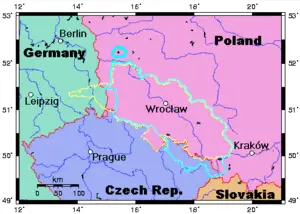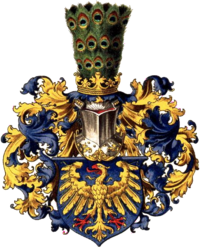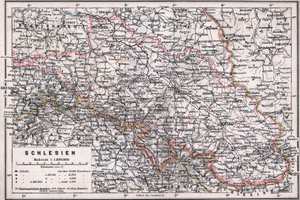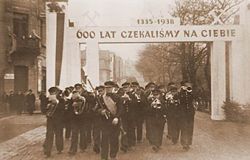Silesia
| Silesia | |
| Language(s): | Silesian, Polish, German, Czech |
| Time zone: | CET (UTC+1) CEST (UTC+2) |
Silesia (Czech: Slezsko; Template:Audio-de; Latin: Silesia; Polish: Śląsk; Silesian: Ślónsk) is a historical region in central Europe. Most of it is now within the borders of Poland, with small parts in the Czech Republic and Germany. Silesia is located along the upper and middle Oder (Odra) River, upper Vistula River, and along the Sudetes, Carpathian (Silesian Beskids) mountain range. The largest cities of Silesia are Wrocław and Katowice.
Silesia is situated entirely in territory named by Tacitus in 98 C.E. Magna Germania. Slavic people arrived to this territory around the 6th century. It became the territory of Greater Moravia and Bohemia. Rulers of Bohemia received ducal authority by pledging allegiance to Emperor Otto I in 950 C.E. With the establishment of the Piast Poland shortly thereafter, Boleslaw I Chrobry united Silesia with the rest of his territories.
In the Middle Ages, Silesia was divided between many independent duchies ruled by a cadet branch of the Piast dynasty. During this time, cultural and ethnical Germanisation increased due to immigrants from the Holy Roman Empire. It subsequently became a possession of the Bohemian crown under the Holy Roman Empire in the 14th century, and passed with that crown to the Habsburg Monarchy of Austria in 1526. The Duchy of Krosno Odrzańskie (Crossen) was inherited by Brandenburg in 1476 and, with the renouncement by Emperor Ferdinand I in 1538, it became an integral part of Brandenburg.
In 1742, most of Silesia was seized by King Frederick the Great of Prussia in the War of the Austrian Succession. This part of Silesia constituted the Province of Silesia (later the Prussian provinces of Upper and Lower Silesia) until 1945, when most of the German part of Silesia was seized by the Soviets and transferred to Poland after World War II. Austrian Silesia, the small portion of Silesia retained by Austria after the Silesian Wars, is now within the borders of the Czech Republic. In the Middle Ages, Silesia was inhabited mostly by people of Slavonic ethnic background and belonged at first to Poland and later to Bohemia. Since the 13th century Silesia together with Bohemia has come under German cultural and political influence. In the 16th century it became part of Austria and a significant part of the inhabitants were germanized. This process continued during the next centuries. In 1742 Prussia conquered most of Silesia, only the southernmost regions (marked in orange on the map below) of Opava and Cieszyn remained Austrian. In 1815 the eastern part of Saxony was incoporated into Silesia, while the northernmost part of Silesia, the enclave of Swiebodzin (Schwiebus) became part of the Province of Brandenburg (marked in red on the map of Brandenburg). In the 19th century the greater part of the Silesian people were Roman Catholics. In the western and central regions practically only German was spoken, while in the eastern part of Silesia (Upper Silesia) the Polish language was predominant. As independent Poland came into existence in 1918, the Polish speaking populace also wanted to belong to it. After three Polish uprisings and a plebiscite, the region was divided between Poland and Germany (the area which then became Polish is shown in green). Small fragments of Middle Silesia (marked in cyan) were also incorporated into Poland and a little area in the south (marked in magenta) - into Czechoslovakia. After WWII, the greater part of Silesia became part of Poland. Only three districts west of the Neisse River remained German (they are now part of the State of Saxony). German inhabitants of the province either escaped or were expelled from Silesia after 1945 and Poles from the formerly Polish regions in the East settled there.
Administration
Silesia is a region of central Europe, extending along both banks of the Oder River and bounded in the south by the mountain ranges of the Sudetes and the Western Carpathians. Politically, almost all of Silesia is divided between Poland and the Czech Republic. The Polish portion comprises most of the former Prussian provinces of Upper Silesia and Lower Silesia, both of which were transferred to Polish administration at the Potsdam Conference of 1945; the Polish portion also includes those parts of Upper Silesia that were ceded by Germany to Poland after World War I and part of the former Austrian principality of Teschen. A second, much smaller part of Silesia belonged to Czechoslovakia since 1918, and became part of the Czech Republic with the dissolution of Czechoslovakia in 1993.
Most of Silesia lies within modern Poland, divided within the following voivodeships (provinces):
- Greater Poland Voivodeship
- Lower Silesian Voivodeship
- Lubusz Voivodeship
- Opole Voivodeship
- Silesian Voivodeship
The Opole and Silesian Voivodeships form Upper Silesia. The small portion in the Czech Republic known as Czech Silesia forms, with the northern part of Moravia, the Moravian-Silesian Region of that country, while the remainder forms a small part of the Olomouc Region.
Traditionally, Silesia was bounded by the Kwisa and Bobr rivers, while the territory west of the Kwisa was Upper Lusatia (earlier Milsko). However, because part of it was included in the Prussian Province of Lower Silesia, in Germany the Niederschlesischer Oberlausitzkreis and Hoyerswerda are considered parts of Silesia. Those districts, along with the Lower Silesian Voivodeship, make up the geographic region of Lower Silesia.
Etymology
One source attributes the origin of the name Silesia to the Silingi, who were most likely a Vandalic (East Germanic) people presumably living south of the Baltic Sea along the Elbe, Oder, and Vistula Rivers in the second century. When the Silingi moved out during the Migration Period, they left remnants of their society behind, the most obvious being the names of places imposed by the new inhabitants, Slavic peoples (Polish: Śląsk; Old Polish: Śląžsk [-o]; Old Slavic: *Sьlьąžьskъ [<*sǐlęgǐskǔ], from Old Vandalic *Siling-isk [land]). These people became associated with the place and subsequently became known as Silesians (using a Latinized form of the Polish name, Ślężanie), although they had little in common with the original Silingi. Archeological research has uncovered former largely populated areas from the 7th and 8th centuries, which were protected by a dense system of fortifications to the west and south; the lack of such systems to the north or east supports the hypothesis that Silesia was populated by early Slavic tribes from the 5th to 13th centuries. Because Goths, another East Germanic group, were settled in eastern Silesia while Slavic Wends lived in western Silesia, there cannot be any mention of a nation.
Another source has it that Silesia is derived from the river Ślęza.
History
Early people
Silesia was inhabited by various peoples in the Stone, Bronze, and Iron Ages. The earliest written sources come from the Egyptian Claudius Ptolemaeus (Magna Germania) and the Roman Gaius Cornelius Tacitus (Germania). Tacitus recorded that the first century Silesia was inhabited by a multi-ethnic league dominated by the Lugii, an East Germanic tribe. The Silingi were also part of this grouping, and so were most likely (East Germanic) Vandals, who lived south of the Baltic Sea in the Elbe, Oder, and Vistula river areas. Other East Germanic tribes also inhabited the scarcely populated region. Slavic tribes entered in the scene in 500 C.E.
Middle Ages
After 500 C.E. the Great Migration had induced the bulk of the original East Germanic tribes to leave Silesia and wander through Southern Europe, while Asian tribes had been arriving for centuries, and Slavic tribes started forming first settlements, including the Silesian lands. Early documents mention a couple of mostly (postulated) Slavic tribes most probably living in Silesia. The Bavarian Geographer (around 845) specifies the following peoples: the Slenzanie, Dzhadoshanie, Opolanie, Lupiglaa, and Golenshitse. A document of the Bishopric of Prague (1086) adds to the list the Zlasane, Trebovyane, Poborane, and Dedositze.
In the 9th and 10th centuries, the territory to be called Silesia was part of Great Moravia, Moravia, and then Bohemia neighboring on the Czech Republic to the south. After the breakup of Great Moravia, Silesia for centuries became a target of protracted disputes and wars mostly between Czech and Polish rulers. Around 990, several parts of Silesia were conquered and annexed to the newly-created Polish state by Duke Mieszko I (see map), although other sources date this event to 999 under the rule of Duke Boleslaus I. During Poland's fragmentation (1138–1320) into duchies ruled by different branches of the Piast dynasty, Silesia was ruled by descendants of the former royal family. the Premyslid Dynasty gain control of Silesia in the 10th century, but by the end of the century, the region was back in the hands of Piasts. The two dynasties vied for the territory until the 12th century.
In 1146, High Duke Władysław II acknowledged the overlordship of the Holy Roman Empire over Poland, but was driven into exile. In 1163 his two sons took possession of Silesia with Imperial backing, dividing the land between them as dukes of Lower and Upper Silesia. They created two main Piast lines in Silesia, Wrocławska (of Wrocław)) and Opolsko-Raciborska (of Opole and Racibórz. The policy of subdivision continued under their successors, with Silesia gradually being divided into 16 principalities by the 1390s.
In 1241, the Mongols invaded Europe—and Silesia—and sowed panic, looting much of the region but abandoning the siege of the castle of Wrocław, supposedly after being fended off by Blessed Cheslav's "miraculous fireball." They then annihilated the combined Polish and German forces at the Battle of Legnica. Upon the death of Ögedei Khan, the Mongols chose not to press forward further into Europe and left, while the region was further disintegrating until it counted almost 20 small administrative units and invited attempts at annexation by the Premyslid Dynasty, focused primarily on Upper Silesia.
The ruling Silesian lords rebuilt some 160 cities and 1,500 towns and restored the most recent administrative divisions, while at the same time introducing the codified German city law (Magdeburg law and Środa Śląska law) in place of the older, customary Slavic and Polish laws. They also made up for the recent population loss by inviting new settlers, mostly German and Dutch colonists from the Holy Roman Empire. Around the end of the 13th or early 14th century, Silesian dukes invited many German settlers to improve their duchies. Germans settled mostly in cities, as did Jews and some Czechs. In the countryside, especially in Upper Silesia, people of Polish origins still outnumbered the rest of the population. The Germans quickly rose to prominent positions in the economic life, although this policy of inviting Germans to colonize and cultivate the barren lands, as well as the assimilation of the ruling classes and the German and Slavic inhabitants, would feed ideological and nationalist tensions between the Poles and Germans in the 19th century and the first half of the 20th century.
In the second half of the 13th century, various knightly orders settled in Silesia, among them the Knights of the Red Star were the Hospitaller, and the Teutonic Knights. Silesia was an integral part of Poland by the 11th century. King Boleslaus III (1102–38), of the Piast dynasty divided Poland into four hereditary duchies, of which Silesia was one, for his sons. After 1200, the duchy of Silesia disintegrated into numerous minor principalities.
Czech king Wenceslas II ascended to the Polish throne in 1300 and annexed most of Lower Silesia to the Kingdom of Gohemia. King John Luxembourg then claimed further parts of Silesia. These territorial gains of Czech kings were acknowledged by the Polish king in 1335 in exchange for the Luxembourg Dynasty’s giving up their claims on the Polish throne. Charles IV Luxembourg then incorporated Silesian duchies into the Czech Crown lands. In the early 14th century, the Silesian princes accepted the king of Bohemia as their suzerain and thus became princes of the Holy Roman Empire.
During the Hussite Wars of the 15th century, Silesia was temporarily detached from the Bohemian crown and was ruled by Hungary. In 1490, however, both Silesia and Moravia reverted to Bohemia, with which they passed to the house of Habsburg in 1526.
Silesian Duchies
In the time of divisions, Piast dukes sought to reincorporate Silesia into the Polish kingdom and reunite the country, the first being Duke Henryk IV Probus of Silesia, but he died in 1290 before realizing his goal. Duke Przemysł II of Greater Poland united two of the original provinces and went on to become king in 1295, but he died by forcible death a year later before being able to accomplish more. In his will he appointed Duke Henryk Głogowski, who also aspired to unite Poland and even claimed the title Duke of Poland, as his successor, but the will of majority prevailed and Duke Władysław I the Elbow-high won. In the meantime, King Wenceslaus II of Bohemia crowned himself King of Poland in 1302, and thus began 50 years of wars between Władysław and his son Casimir III the Great and a coalition of Bohemians, Brandenburgers and Teutonic Knights, who sought to divide Poland. Since most Silesian dukes controlled small chunks of the territory, they lacked the clout to unite with Poland, despite their ties with it, and thus fell under the influence of neighboring Bohemia.
In 1335 Duke Henry VI of Breslau and the Upper Silesian dukes recognized the overlordship of King John I of Bohemia, and in 1348 King Casimir III of Poland had to hand most of Silesia to Bohemia, ruled by Emperor Charles IV. Thus the duchies of Silesia were incorporated into the Holy Roman Empire. Breslau in particular benefited from these developments, with a large number of large Gothic buildings and churches being built.
Over the following centuries the lines of the Piast dukes of Silesia died out and were inherited by the Bohemian crown:
- Wrocławska (of Wrocław) in 1335;
- Świdnicka (of Świdnica) in 1368;
- Oleśnicka (Oleśnica and Głogów) in 1476;
- Żagańska (of Żagań) in 1504;
- Opolska (of Opole) in 1532;
- Cieszyńska (of Cieszyn) in 1625;
- and Brzesko-Legnicka (of Brzeg and Legnica) in 1675.
By the end of the 14th century Silesia had been partitioned into 18 principalities: Breslau, Brieg, Glogau, Jauer, Liegnitz, Munsterberg, Ols, Schweidnitz, and Steinau in Lower Silesia, and Beuthen, Falkenberg, Kosel, Neiße, Oppeln, Ratibor, Strehlitz, Teschen, and Troppau in Upper Silesia. Their petty rulers gave in to internecine quarrels and failed to curb the lawlessness of their feudal vassals. Except for several dukes of Lower Silesia, such as Henry I and Bolko I, and Henry II and IV, who succeeded in reuniting most of the principalities under their sway, the country fell into a state of crippling anarchy.
From the 13th century onward the population of the region became increasingly Germanized through the arrival of more German settlers and the assimilation of local rulers and peasants within this new German majority.
Religious Strife
Hussite Wars
During the Hussite Wars in Bohemia, Silesia was loyal to Catholicism, with an exception of Cieszyn Silesia, where Hussite ideas resonated with the local population. However, allegiance to Bohemia’s Catholic King Sigismund Luxembourg and an active role of Silesian dukes in the first two crusades against the Hussite Bohemia led to a series of invasions between 1425 and 1435 by which the region was severely devastated. The Silesians regarded Bohemian rebels as dangerous to the Silesian German nationality; indeed, the Hussites targeted the German population during their raids in the region. Many of Silesian towns gave in without resistance and were transformed into military garrisons. Some regions, especially Upper Silesia, became partly Slavic-speaking again. This period lasted until the Battle of Lipany in 1434, after which the Hussites withdrew from Silesia.
The death of Sigismund Luxembourg brought uncertainty, and when the Hussite George of Podebrady (Jiří z Poděbrad) ascended to the Czech throne in 1457 and the restitution of the Slavonic nationality was looming, Silesian dukes, most notably the burghers of Breslau, refused to recognize him as their king and in 1469 accepted Hungarian king Matthias Corvinus instead. In late 1470s, George’s successor and Matthias Corvinus divided up Silesia, with Moravia, Silesia and Luzice going to Matthias and the entire Kingdom of Bohemia going to Vladislaus Jagellon. Both used the title of the Czech king. Matthias took many steps toward the centralization of Silesian administration, employing mercenaries and land grabs from dissenting nobles. Despite these reforms, the Silesians grew resentful of the financial tactics of Matthias, and after his death the region went back to the Czech Crown. During the rule of Matthias’s feeble successor Vladislaus Jagellon, Silesia managed to secure virtual autonomy.
A turnabout came with the rule of the German king Ferdinand I, who had been previously occupied with wars with the Turks. He reasserted the control of the Bohemian Crown by abolishing all of its privileges and imposed a more rigid centralized government, in which activities of the provincial diet were restricted and foreign policy decision-making taken away. The Bohemian rulers continued to claim further territory after the extinction of Silesian dynasties as the surviving princes watched by passively. By 1550 Silesia was almost completely under foreign administration but continued to enjoy economic ties with the neighboring Kingdom of Poland during the Renaissance period and beyond, especially through the Jewish merchants in the cities.
Religious Reformation
The Protestant Reformation of the 16th century took an early hold in Silesia, and most inhabitants became Lutheran. At the same time, pastors aided the renaissance of Slavic culture and language.
In 1526, Ferdinand I of the Habsburg dynasty was elected King of Bohemia, and in the same year he incorporated the Bohemian Kingdom into the Habsburg dynasty as Germanization intensified and Silesia's ties with Poland weakened. Ferdinand I then invalidated a treaty that would transfer the Piast principalities to the Hohenzollerns of Brandenburg upon the extinction of the Piast dynasty.
The religious conflicts and wars of the Reformation and Counter Reformation in the 17th century drove many Silesian Protestants to seek refuge in the tolerant Polish-Lithuanian Commonwealth. Thousands settled in the province of Greater Poland, under the protection of powerful Protestant magnates. Members of the Czech Brethren, under the leadership of Johan Amos Comenius, settled in Leszno. Protestant Silesians often circumvented stringent laws by building their churches on the Polish side of the border.
Thirty Years' War
The tensions between Catholics and Protestants boiled over at the turn of 16th and 17th centuries. Protestant estates took advantage of the protracted disputes between Rudolf II Habsburg and his brother Matthias and secured religious freedom in 1609, first for the Czech lands and a month later for Silesia. Silesian non-Catholic estates cooperated with other non-Catholic estates in the Habsburg monarchy, for which they had retaliatory measures imposed on them by Ferdinand II after the Battle of the White Mountain in 1620.
The Thirty Years' War (1618–48), sparked by the second "Defenestration of Prague" in 1618 in the wake of Ferdinand II 's attempts to restore Catholicism and stamp out Protestantism in Bohemia, brought untold misery to Silesia under successive Saxon, imperial, and Swedish occupation. Although Ferdinand requested assistance from the mostly Catholic Polish-Lithuanian Commonwealth, the Polish szlachta leaned toward the Bohemian and Hungarian nobility despite their religious differences and defied King Sigismund III Vasa's attempt to assist the Habsburgs. Sigismund thus dispatched an unemployed mercenary group called the Lisowczycy in late 1619, hoping to regain parts of Silesia in exchange for aiding the Habsburgs. The Lisowczycy's support would prove decisive during the Battle of White Mountain. However, as the Habsburg situation started looking better, Ferdinand II decided not to grant any concessions to Silesia, nor did he provide help during Poland's war against the Ottoman Empire. The Polish kings never received more than vague promises and several brides to keep them favorably inclined toward the Habsburg dynasty.
Silesia reverted to Austrian control with the Treaty of Westphalia (1648), which ended the Thirty Years’ War. The Habsburgs encouraged Catholicism and succeeded in reconverting to Catholicism about 60% of the population of Silesia, although Lutheranism was tolerated in Breslau and a few other districts. Nevertheless, Protestants were able to erect a mere three new churches, which had to be built of wood, free of spires and outside municipal fortifications. Jesuits proved instrumental in the reintroduction of Catholicism, having funded schools for the privileged and non-privileged classes alike. In 1675, the death of the last Piast compelled Austria to incorporate the Piast territories into the Bohemian Lands.
Under Prussia, Germany, and Austria
The last years of Silesia affiliated with the Kingdom of Bohemia came with Empress Maria Theresa, when King Frederick II, as the heir of the house of Brandenburg, claimed a portion of Silesia in 1740 from her. His occupation of Silesia was welcomed not only by Protestants and Germans but also by many Silesians. Moreover, Frederick began the War of the Austrian Succession (1740-1748), by whose end the Kingdom of Prussia had conquered almost all of Silesia, and only the southeastern tip remained possession of the Habsburg Monarchy. The Silesian Wars (1740–1742 and 1744–1745) were fought as part of the War of the Austrian Succession.
The Seven Years' War (1756-1763) confirmed Prussian control over most of Silesia. After the Napoleonic Wars in 1815, the area around Görlitz was incorporated into the province, and German language became one of choice in Lower Silesia, whereas Polish and Czech dialects were spoken in the countryside of Upper Silesia. German was the common language in the majority of Silesian cities.
Maria Theresa closed a secret deal with Frederick II, giving him Lower Silesia in exchange for neutrality in the Habsburg conflicts with Saxony, Bavaria, and France. However, in November of 1741, he switched allegiance and joined the anti-Habsburg coalition, which cost the Habsburgs most of Silesia in favor of Prussia.
During the Industrial Revolution of the late 18th and 19th cent. textile weaving and coal mining flourished in Silesia, albeit amid social tensions that were polarized along ethnic groups. The upper and middle classes were predominantly German; the workers were mostly Polish. Work conditions gradually improved, although Silesia remained a relatively backward area even in the 20th century despite high productivity.
As a Prussian province, Silesia became part of the German Empire during the unification of Germany in 1871. There was considerable industrialization in Upper Silesia, and many people moved there at that time. The overwhelming majority of the population of Lower Silesia was by then German-speaking and many were Lutheran, including the capital Breslau. There were areas such as the District of Oppeln (then Regierungsbezirk Oppeln) and rural parts of Upper Silesia, however, where a larger portion or even majority of the population was Slavic-speaking and Roman Catholic. In Silesia as a whole, ethnic Poles comprised about 30% of the population, but most of them lived around Katowice in the southeast of Upper Silesia. Many people from Poland moved into Germany, coming through Silesia, often going to Berlin during Industrialisation. and particularly to get away from Russian Polish territory. The installation of trains made mass movements possible and there were times, that trains would not stop in the eastern parts of Germany in order to curb the massive onslaught of people moving in from the east. The Kulturkampf set Catholics in opposition to the government and sparked a Polish revival, much of it fostered by Poles from outside of Germany, in the Upper Silesian parts of the province. The first conference of Hovevei Zion groups took place in Kattowitz (Katowice), German Empire in 1884.
At the same time, the areas of Ostrava and Karvina in Austrian Silesia became increasingly industrialized. Most of the Polish-speaking people there, however, were Slavic Lutherans in contrast to the German-speaking Catholic Habsburg dynasty ruling Austria-Hungary.
In 1900 the population numbered 680,422, which corresponds to 342 inhabitants per square mile (132/km²). The Germans formed 44.69% of the population, 33.21% were Poles and 22.05% Czechs and Slays. According to religion, 84% were Roman Catholics, 14% Protestants and the remainder were Jews. The local diet is composed of 31 members, and Silesia sends 12 deputies to the Reichsrat at Vienna. For administrative purposes Silesia is divided into 9 districts and 3 towns with autonomous municipalities: Troppau, the capital, Bielitz and Friedek. Other principal towns are: Teschen, Polnisch-Ostrau, Jagerndorf, Karwin, Freudenthal, Freiwaldau and Bennisch.
Great World Wars
The Treaty of Versailles (1919) granted the population of Upper Silesia a right to determine the future of the province, with the exception of a 333 km² area with German majority around Hlučín that was granted to Czechoslovakia in 1920, but the Czechoslovak government did not endorse the proposed division and invaded Cieszyn Silesia in 1919, stopping on the Vistula River near Skoczów.[1][2] Conversely, the planned plebiscite was not held and the present-day border between Poland and the Czech Republic was decided in 1920 by the Ambassadors' Council at the Treaty of Versailles. The delineation of the rest of the region was accomplished in the 1921 plebiscite whose outcome was in favor of Germany except the easternmost Upper Silesia, predominantly Polish, where an armed conflict in 1922 compelled the League of Nations to grant the larger part of the industrial district, including Katowice, to Poland. The contested Teschen district was partitioned in 1920 between Poland and Czechoslovakia to the satisfaction of neither. The boundaries often cut through mines; some workers slept in one country and worked in another. The Munich Pact of 1938 divided most of Czech Silesia between Germany and Poland, and after the German conquest of Poland in 1939, the entire Polish Silesia was annexed to Germany.
Interwar Period
Following three Silesian Insurrections in 1919-1921 instigated by Polish inhabitants of the area, the League of Nations decided that the easternmost Upper Silesian, where a majority had voted to remain inside Germany, should be granted autonomy with Silesian Parliament as a constituency and Silesian Voivodship Council as the executive body. The major part of Silesia, remaining in Germany, was incorporated into Upper Silesia and Lower Silesia. Cieszyn Silesia was taken over by Poland from Czechoslovakia in 1938, in accord with the Munich Agreement that surrendered Czechoslovakia to Nazi Germany in the same year. The German Reich retook possession of the mostly Polish parts of Upper Silesia in 1939 after the invasion of Poland, which marked the beginning of World War II. The local German populations frequently welcomed the Wehrmacht and a slew of concentration camps were constructed in many Silesian cities.
Silesia after WWII
In 1945, Silesia was occupied by the Soviet Red Army and the Communist Polish Army. By then a large portion of the German population were expelled from Silesia or had fled for fear of retribution by Soviet soldiers, but many returned after Germany's capitulation. Under the terms of the agreements at the Yalta Conference of 1944 and the Potsdam Agreement of 1945, German Silesia east of the rivers Oder and Lusatian Neisse was granted to Poland and most of the remaining Silesian Germans, who before World War II amounted to more than four million, were displaced or sent to labor camps where many perished. Over 30,000 Silesian men were deported to Soviet mines and Siberia. After the war, local industry was rebuilt and the region repopulated by Poles.
After World War II, the pre-1938 boundaries were restored, but all formerly Prussian Silesia east of the Lusatian Neisse was placed under Polish administration. The German population of the Czech, Polish, and Polish-administered Silesia was forced to leave. West Germany finally relinquished all claims to the area under the terms of a 1972 nonaggression pact with Poland, an act that was affirmed with the unification of East and West Germany in 1990.
Natural resources
Silesia is a populous and resource-rich region, with coal and iron deposits and booming manufacturing. Lower Silesia between the cities of Legnica (Liegnitz), Lubin and Polkowice is the largest centre of copper mining in Poland. The fall of Communism, however, has brought to light the obsolete facilities that inevitably pose environmental problems. The region also boasts thriving agriculture, producing mainly grains, potatoes, and sugar beets. Except in the south, Silesia is largely an agricultural and forested lowland, drained by the Oder and its tributaries. The major city of the region is Wroc aw. Along the slopes of the Sudetes there are numerous small industrial centers with traditional textile and glass industries. Czech Silesia comprises the rich Karvinna coal basin. The most important part of Silesia is, however, its southern tip—Upper Silesia, in Poland. One of the largest industrial concentrations of Europe, it has extensive coal and lignite deposits and zinc, lead, iron, and other ores. The industrial area around Katowice comprises such important centers as Bytom, Gliwice, Zabrze, and Cz stochowa, and has iron and steel mills, coke ovens, and chemical plants. Opole, the former capital of Upper Silesia, is an important trade center.
Demographics
Modern Silesia is inhabited mostly by Poles and Silesians, but also by minorities of Germans, Czechs, and Moravians. The last Polish census of 2002 showed that the Slavic Silesians are the largest ethnic minority in Poland, Germans being the second — both groups are located mostly in Upper Silesia. The Czech part of Silesia is inhabited by Czechs, Moravians, and Poles.
Before the Second World War, Silesia was inhabited by Germans, Poles, and Czechs. The 1905 census showed that 75% of the population was German and 25% Polish. The vast majority of German Silesians fled or were expelled from Silesia during and after World War II. Most ethnic German Silesians today live in the territory of the Federal Republic of Germany, many of them working as miners in the Ruhr area, as did their ancestors in the Silesian mines. In order to facilitate their integration into West German society after 1945, the West German government established and sponsored organizations such as the Landsmannschaft Schlesien. Public opinion in Germany favors reconciliation of these organizations with the Polish Silesians, which is already in the making. Many of the pre-war Germanized Slavic Silesians living in Upper Silesia have remained culturally united and have sought work in the Federal Republic of Germany after 1990, along with their ethnic German Silesian countrymen.
Cities in Silesia
The following table lists cities in Silesia with a population greater than 100,000 (2006):
| Wrocław |
| Katowice |
| Ostrava |
| Opole |
| Official name | German name | Population | Area | Administrative | Country | ||
|---|---|---|---|---|---|---|---|
| 1 | Wrocław | Breslau | 635 932 | 293 km² | Lower Silesian V. | ||
| 2 | Katowice | Kattowitz | 317 220 | 165 km² | Silesian Voivodeship | ||
| 4 | Ostrava | Ostrau | 309 531 | 214 km² | Moravian-Silesian R. | ||
| 4 | Gliwice | Gleiwitz | 199 451 | 134 km² | Silesian Voivodeship | ||
| 5 | Bytom | Beuthen | 187 943 | 69 km² | Silesian Voivodeship | ||
| 6 | Zabrze | Hindenburg | 191 247 | 80 km² | Silesian Voivodeship | ||
| 7 | Bielsko-Biała | Bielitz | 176 864 | 125 km² | Silesian Voivodeship | ||
| 8 | Ruda Śląska | Ruda | 146 658 | 78 km² | Silesian Voivodeship | ||
| 9 | Rybnik | Rybnik | 141 580 | 148 km² | Silesian Voivodeship | ||
| 10 | Tychy | Tichau | 131 153 | 82 km² | Silesian Voivodeship | ||
| 28 | File:POL Opole COA.svg | Opole | Oppeln | 128 268 | 97 km² | Opole Voivodeship | |
| 11 | File:POL Wałbrzych COA.svg | Wałbrzych | Waldenburg | 126 465 | 85 km² | Lower Silesian V. | |
| 12 | File:POL Zielona Góra COA.svg | Zielona Góra | Grünberg | 118 221 | 58 km² | Lubusz Voivodeship | |
| 13 | Chorzów | Königshütte | 114 686 | 33 km² | Silesian Voivodeship | ||
| 14 | Legnica | Liegnitz | 105 750 | 56 km² | Lower Silesian V. |
Footnotes
Sources and Further Reading
- Długajczyk, Edward, Tajny front na granicy cieszyńskiej : wywiad i dywersja w latach 1919-1939, Katowice, Śląsk, 1993, ISBN 8385831037 OCLC 34150911
- Zahradnik, Stanisław Zahradnik; Ryczkowski, Marek, Korzenie Zaolzia, Warszawa, PAI-press, 1992
- Butler, Rohan, Documents on British Foreign Policy 1919-1939, London, Her Majesty's Stationary Office, 1961, OCLC: 63769283
- Medlicott, W.N.; Dakin, Douglas; Lambert, M.E., Documents on British Foreign Policy 1919-1939, London, Her Majesty's Stationary Office, 1968, ISBN 0115915591 OCLC 58619553
- Davies, Norman; Moorhouse, Roger, Microcosm, Portrait of a Central European City, London, Jonathan Cape, 2002, ISBN 0224062433 OCLC 49551193
External links
- Republic of Silesia, REPUBLIKA S'LOONSKO, Accessed February 3,2007
- Silesia on Germany Map of 1600, Blaeu Atlas, Accessed February 3,2007
- Historical Map of Silesia 1763, Thomas Höckmann, Accessed February 3,2007
- Willkommen im schlesischen Museum!, Manfred Schürmann, Accessed February 3,2007
- Historical Maps: Silesia, German Genealogy, Accessed February 3,2007
- Where is Upper Silesia?, Geography, Accessed February 3,2007
- Silesian Autonomy Movement, Ruch Autonomii Śląska, Accessed February 3,2007
http://www.polishroots.com/genpoland/sil.htm http://www.bartleby.com/65/si/Silesia.html http://www.britannica.com/eb/article-9067752/Silesia http://www.answers.com/topic/silesia
Credits
New World Encyclopedia writers and editors rewrote and completed the Wikipedia article in accordance with New World Encyclopedia standards. This article abides by terms of the Creative Commons CC-by-sa 3.0 License (CC-by-sa), which may be used and disseminated with proper attribution. Credit is due under the terms of this license that can reference both the New World Encyclopedia contributors and the selfless volunteer contributors of the Wikimedia Foundation. To cite this article click here for a list of acceptable citing formats.The history of earlier contributions by wikipedians is accessible to researchers here:
The history of this article since it was imported to New World Encyclopedia:
Note: Some restrictions may apply to use of individual images which are separately licensed.








